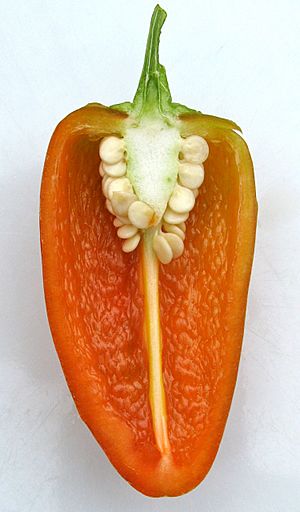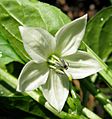Fresno chile facts for kids
Quick facts for kids Fresno chile |
|
|---|---|

Cross section of a Fresno chile pepper
|
|
| Species | Capsicum annuum |
| Cultivar group | New Mexico chile |
| Cultivar | Fresno chile |
| Heat | |
| Scoville scale | 2,500–10,000 SHU |
The Fresno chile is a type of pepper that's not too spicy, but not super mild either. It's often called the Fresno chili pepper. It's a medium-sized pepper from the Capsicum annuum plant family. People sometimes confuse it with the jalapeño pepper. But Fresno chiles have thinner walls and are usually a bit milder. They also grow faster!
Unlike jalapeños, Fresno chiles are a type of New Mexico chile. They grow pointing upwards on the plant, while jalapeños point down. When they first grow, they are bright green. As they get older, they turn orange and then red. A full-grown Fresno pepper looks like a cone. It's about 2 inches long and 1 inch wide at the top. These plants love warm, sunny weather and don't like cold at all. They can grow to be about 2 to 2.5 feet tall.
Contents
History of the Fresno Chile
The Fresno chile was created by a person named Clarence Brown Hamlin. He developed this pepper in 1952. Hamlin decided to name the pepper "Fresno" to honor Fresno, California. Today, these peppers are grown all over California. You'll find many of them in the San Joaquin Valley.
How People Use Fresno Chiles
Fresno chiles are used in many tasty dishes. They are often found in ceviche, which is a seafood dish. They are also popular in salsa. You might see them served with rice and black beans. These peppers don't dry well because their walls are thick. So, they aren't usually made into chili powder.
In cooking, you can often use Fresno chiles instead of jalapeño or serrano peppers. You can buy the milder green ones in the summer. The spicier red ones are available in the fall. How the pepper is used depends on how ripe it is.
Green Fresno Peppers
Young, green Fresno peppers are very useful in the kitchen. They add a mild spice and flavor to many meals. You can put them in sauces, chutneys, dips, and relishes. They are also great in casseroles, soups, and stews. Green Fresnos can even be pickled and eaten whole. They make a colorful topping for Mexican and Southwestern American foods.
Red Fresno Peppers
Older, red Fresno peppers are hotter than green ones. They have less flavor but more heat than jalapeño peppers. People often add them to salsas, relishes, and marinades. They are also good toppings for tacos, burgers, and hot dogs. Red Fresno peppers are big enough to be stuffed with cheese, potatoes, or meat. Some recipes use them to make special sauces like Romesco and rojo cream sauces.
Health Benefits of Fresno Chiles
Fresno chiles are packed with good things for your body! They are an excellent source of vitamin C and B vitamins. They also have a lot of iron, thiamin, niacin, magnesium, and riboflavin. These peppers are low in calories, fat, and salt. They can even help lower cholesterol. The red, ripe peppers have the most of these healthy nutrients.
The spicy part of the chile comes from a chemical called capsaicin. This compound can help reduce swelling and pain. It also helps you feel full after eating. Chiles also contain important minerals like potassium, manganese, iron, and magnesium.





